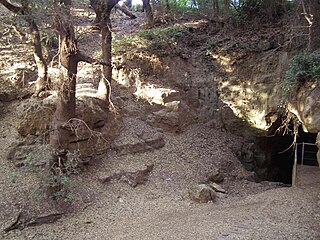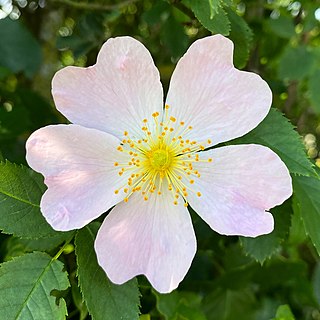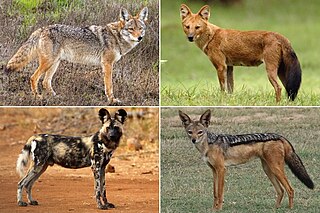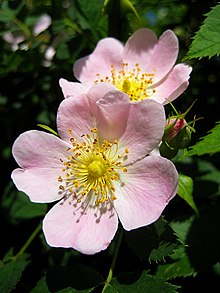
A rose is either a woody perennial flowering plant of the genus Rosa, in the family Rosaceae, or the flower it bears. There are over three hundred species and tens of thousands of cultivars. They form a group of plants that can be erect shrubs, climbing, or trailing, with stems that are often armed with sharp prickles. Their flowers vary in size and shape and are usually large and showy, in colours ranging from white through yellows and reds. Most species are native to Asia, with smaller numbers native to Europe, North America, and northwestern Africa. Species, cultivars and hybrids are all widely grown for their beauty and often are fragrant. Roses have acquired cultural significance in many societies. Rose plants range in size from compact, miniature roses, to climbers that can reach seven meters in height. Different species hybridize easily, and this has been used in the development of the wide range of garden roses.

The rose hip or rosehip, also called rose haw and rose hep, is the accessory fruit of the various species of rose plant. It is typically red to orange, but ranges from dark purple to black in some species. Rose hips begin to form after pollination of flowers in spring or early summer, and ripen in late summer through autumn.

Rosa dumalis, the glaucous dog rose, is a species of rose in the Rosaceae family. The native range of this rose stretches from Europe to the Caucasus and also down to northwestern Africa.
Wild rose is the common name of certain flowering shrubs:

Rosa canina, commonly known as the dog rose, is a variable climbing, wild rose species native to Europe, northwest Africa, and western Asia.
Rose hip seed oil is a pressed seed oil, extracted from the seeds of the wild rose bush Rosa rubiginosa in the southern Andes. Rosehip seed oil can also be extracted from Rosa canina, a wild rose species native to Europe, northwest Africa, and western Asia. The fruits of the rosehip have been used in folk medicine for a long time. Rosehips have prophylactic and therapeutic actions against the common cold, infectious diseases, gastrointestinal disorders, urinary tract diseases, and inflammatory diseases.

Eriodictyol is a bitter-masking flavanone, a flavonoid extracted from yerba santa, a plant native to North America. Eriodictyol is one of the four flavanones identified in this plant as having taste-modifying properties, the other three being homoeriodictyol, its sodium salt, and sterubin.

Cnaemidophorus rhododactyla, also known as the rose plume moth, is a moth of the superfamily Pterophoroidea, family Pterophoridae. It is found in the Northern Hemisphere, except for Greenland, Southeast Asia, and most of North Africa. It was first described by Michael Denis and Ignaz Schiffermüller, 1775.

The rose leaf miner is a moth of the family Nepticulidae. It is found in all of Europe, east to the eastern part of the Palearctic realm.

Pa'ar Cave is a karstic sinkhole in the Upper Galilee, Israel.

The Ratonero Valenciano, also known as the Gos Rater Valencià, is a breed of dog that originates in Spain. Recognised by the Real Sociedad Canina de España in 2004, it has had recent success with a member of the breed winning the Spanish National Dog Show in 2011. It is a traditionally docked breed. In 2022, the FCI finally recognised the breed, naming it rather "Terrier" than "Ratter".

The Thousand-year Rose, also known as the Rose of Hildesheim, grows on the apse of the Hildesheim Cathedral, a Catholic cathedral in Hildesheim, Germany, that is dedicated to the Assumption of Mary. The cathedral and the adjacent St. Michael's Church have been on the UNESCO list of World Heritage Sites since 1985.

Rosa corymbifera, the thicket dog rose, is a species of flowering plant in the family Rosaceae. It is native to northwestern Africa, nearly all of Europe, the Caucasus, the Middle East, and Central Asia. It primarily differs from the dog rose Rosa canina in having downier leaves, particularly on the abaxial surfaces. The most widely used rootstock in Europe for garden roses is its cultivar 'Laxa'.

Canina is a taxonomic rank which represents the wolf-like subtribe of the tribe Canini, and is sister to the subtribe Cerdocyonina. Fossils of this group date to 5 million years ago, however they are likely to have been in existence 9 million years ago. Its members as a group are colloquially known as the wolf-like canids.

Rosa agrestis, the small-leaved sweet briar, field briar or fieldbriar, is a species of wild rose native to Europe, found mostly in southern Europe and occasionally as far as the Caucasus. Sources differ on whether it can be found in northern Africa and Anatolia.

Rosa mollis is a species of wild rose. Common name: soft downy-rose. It is most closely related to Rosa villosa. Rosa mollis can be distinguished from Rosa villosa by its longer leaves and pruinose stem, which is absent in the latter. Rosa mollis usually blossoms in Germany for approximately 5 weeks from the end of June to July

Rosa subsection Caninae is one of several subsections of the section Caninae in the genus Rosa. It includes Rosa canina, commonly known as the dog rose.















